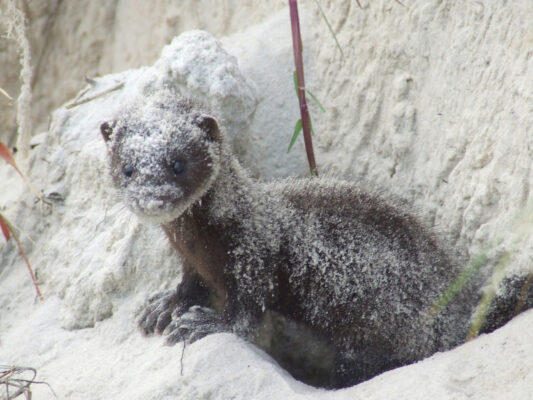There’s a small otter-like critter roaming our saltmarshes and beach shores, but few people ever encounter one. We have mink here in Nassau County and even on Amelia Island. It turns out that Florida Fish and Wildlife Conservation Commission researchers studying mink in Florida have deemed our area a hotspot for these elusive and curious mustelids, a mink paradise here of sorts.

There are four different types (subspecies) of mink in Florida and we are home to the Atlantic saltmarsh mink, only found from here to South Carolina along the coast and saltmarshes. Years ago I photographed a mink roaming the beach near the beach campground of Fort Clinch State Park at dawn. I spent precious minutes following this small creature as it gobbled up grasshoppers and crabs and now and again popped into ghost crab holes to look for its residents. One of my photos from that experience has been widely shared by researchers and naturalists in Florida and even made its way into a couple of books about Florida nature. It looks like a mink in a snowbank. You can see it here for yourself. Other people have reported mink to me, sighted on their boat docks and saltmarsh-neighboring properties. But I’ve never seen one here again.
Until now, that is, thanks to Jonathan Howard of the Ark Wildlife Wildlife Care and Sanctuary in Hilliard, I’ve now seen one again, up close and personal. Jonathan contacted me a week or so ago with a photo of what looked like a very tiny otter baby in his hand, a new arrival at his rehabilitation center. This little critter weighing less than 1/3 of a pound floated into someone’s yard on a raft of marsh grass (Like Baby Moses, Jonathan joked). The finders left it there for a day waiting for the mother to return, but she never did and it was taken to the ARK.

At first, we thought it was a newborn otter, but no umbilical cord, and much more vibrant than a newborn would be. But the paws weren’t right for an otter, or even its face. It was a mink! At the ARK this little guy greedily took to the bottle and a few days later, he opened his eyes, the cutest face ever! But wow did he stink at first, Jonathan reported. He said a strong chemical-like smell pervaded the baby mink no matter how carefully and often he bathed it. I just had to smell (and see) this for myself!
A few days later I visited the ARK and held this wiggly hyperactive little critter. What a cutie! And, the smell was not strong at all. Mustelids like otters, skunks and mink all have scent glands that they put into play when frightened, or when marking their territories with their own unique scent. Studies on otters prove that their scent deposits inform others of the species on the sex, age, and individuality when they passed by and even the food sources of these animals as they roam their territories. Most likely minks do the same. Jonathan conjectures that maybe that baby, before its eyes opened, had not yet gained control of this bodily function.

When I held the baby mink there was not much of a smell, and what I could smell was pleasant to me. But keep in mind that I spent 10 or more years of my life coated with otter scent when I handled my own captive river otters and loved it! Really the only smells that knocked me out at the ARK came from the many captive silver and red foxes he provided sanctuary for. But Jonathan was used to that smell I’m sure, like I am with mustelid smells. Each to his own.
This young mink will be bottle-fed until he can be switched to solid food, then live prey and by the 180-day period that the ARK is permitted to care for orphans it will be released to the wild to live the wild life he deserves. But for now, I am happy I got a chance to meet him! Life is full of unexpected pleasures, at least for me …
Pat Foster-Turley, Ph.D., is a zoologist on Amelia Island. She welcomes your nature questions and observations. [email protected]
